Top News

September 11, 2017 Ryukyu Shimpo
On September 11, The Ministry of Defense announced a summary of a report by the U.S. military of an accident in which an MV-22 Osprey vertical take-off and landing transport aircraft belonging to the Futenma Air Station crashed off the coast of Abu, Nago City, in December last year.
According to the announcement, the accident was caused by the pilot making a mistake during aerial refueling training under difficult weather conditions.
The summary of the report stated there were no signs the accident was caused by an aircraft fault or by improper maintenance.
According to the Ministry of Defense’s announcement, the accident took place during aerial refueling training on the evening of December 13, 2016.
The MV-22’s right propeller was damaged when it made contact with the MC-130’s refueling basket.
This led to the accident.
On the day of the accident, the Osprey attempted to refuel from the MC-130 several times, but failed.
The pilot decided to return to the Futenma base because a warning light indicated a lack of fuel.
The MV-22 was on its way back to Futenma when its propeller was damaged during an attempted aerial refueling.
On the morning of September 11, Lt. Gen. Lawrence D. Nicholson, the commanding general for III Marine Expeditionary Force and Okinawa Area Coordinator, explained the circumstances of the accident to Vice Governor Moritake Tomikawa.
(English translation by T&CT)
Go to Japanese

September 7, 2017 Ryukyu Shimpo online edition
In Okinawa City, a project called “The Origami Crane Project: The Longest Origami Crane Lei” has been underway in an attempt to set a Guinness World Record for the longest chain of connected origami cranes.
On September 7 at the Okinawa City Gymnasium the length measurement of the chain was disclosed at 9775.33 meters.
This exceeds the Guinness World Record set in Hiroshima City in 2013, the length of which was 7000 meters.
Citizens folded 33,380 origami cranes for this project.
When Guinness World Record adjudicator Mai McMillan announced that Okinawa City had set a new record, the room was engulfed in the applause and cheers of gathered citizens.
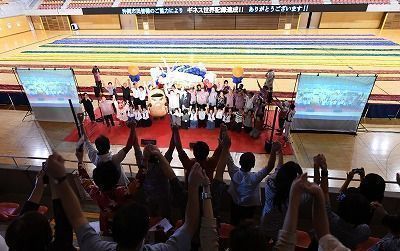
At about 3:31 p.m. at Okinawa City Gymnasium, those involved in making the more than 9700-meter paper crane lei delight in their achievement of a Guinness World Record.
The Battle of Okinawa surrender ceremony took place on land which is now within Kadena Air Base, but which was formerly Goeku Village, on September 7 in 1945.
The Okinawa City Citizens’ Day of Peace was established on this date in 1993.
The origami crane lei project’s length reveal was planned to coincide with this commemorative event in order to make the Okinawa City Citizens’ Day of Peace more widely known and to create a trend toward peace.
The goal for the project was to make the chain 9700 meters long.
The origami crane lei will be on display in the Okinawa City Office lobby from October 9 through 12 this year.
After the measurement was disclosed, Mayor of Okinawa City Sachio Kuwae said with gratitude: “Regardless of age, gender, or ability, many people collaborated to make this happen.
I think that each time September 7 rolls around, I will recall this day.”
Junior high school students from Okinawa City who were selected to be ambassadors for peace at the ceremony gave information on the activities of the day and performed Heiwa Songu (the Peace Song) out loud and in sign language simultaneously.
(English translation by T&CT and Erin Jones)
Go to Japanese
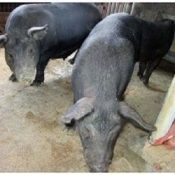
September 6, 2017 Ryukyu Shimpo
Okinawa Prefecture is moving forward with a plan to freeze the semen of select Agu pigs, the native pig breed in Okinawa.
As part of a plan to improve Okinawa Agu pork, pigs that grow quickly and produce the best meat will have their semen frozen, which will thereafter be distributed to pig farmers.
Currently, they are developing a DNA chip that can effectively analyze genetic capacity of the pigs as well as a method for sorting animals for superior breeding.
A trial distribution of frozen pig semen to farmers could begin as early as the beginning of next year.
While the Agu pig has an already established reputation for their quality meat, the expectation is that breeding animals with the best genes will
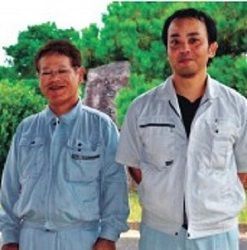
Okinawa Livestock Research Center scientists Genji Oyadomari (left) and Tsugihira Toma – Nakijin, Okinawa
produce even better results, with the hopes that this, “leads to the tastiest pork in the world,” as someone connected to the project enthused.
The research is being conducted by the Okinawa Livestock Research Center in Nakijin, and centers around frozen preservation technology for semen, and establishing an improved breeding process by effectively utilizing the full Agu pig genome that was decoded in 2015.
A similar undertaking for improving Japanese beef based on bovine growth and meat quality using frozen bovine semen is also underway.
While Agu pork has a good reputation for the quality of its meat, breeding among a small herd over a long period of time has led to extremely weak reproductive power, at the heart of which was the reliance on natural breeding.
Research up until now has determined that the first 50 milliliters discharged at ejaculation contained the highest semen content, and that
using a tube when artificially inseminating the female led to a higher conception rate.
The process of freezing semen can also eliminate or deactivate pathogens which can wreak havoc on the livestock business,
causing miscarriages and stunted growth.
Additionally, the ability to ship in the summer, when storage issues lead to a reduced copulation rate, will also lead to a healthier livestock industry overall.
If frozen semen can be used sustainably, it will allow the best genes to be used for much longer.
The native Okinawan Agu has trouble building its brand and cannot be transported off the island, and its continued existence would be put in jeopardy if there were an epidemic of a livestock-affecting disease such as foot-and-mouth disease.
It is also expected that by sustainably using frozen semen, it would allow for the elimination and prevention of genetic disorders.
Two researchers from the Livestock Research Institute, Genji Oyadomari and Tsugihira Toma, commented, “Agu exist only in Okinawa, and we feel it is important to preserve and improve their exceptional bloodline. We hope it leads to an improvement of the Agu brand.”
(English translation by T&CT and Sam Grieb)
Go to Japanese
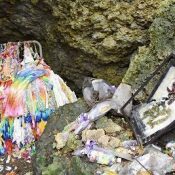
September 12, 2017 Ryukyu Shimpo Digital Edition
Yomitan – Chibichiri Gama, a cave in Namihira, Yomitan where civilians were forced to commit suicide by the Japanese military after the Battle of Okinawa, was discovered to be vandalized on the morning of September 12.
Shoichi Chibana, who for many years has been involved in activities such as collecting an oral history of the cave, made the discovery around 11 a.m. while giving a tour to a journalist acquaintance.
Remains that had been collected inside the cave had also been destroyed.
According to the Bereaved Families Association, the cave was in good condition during the Bon festival on September 5.
The remains left inside the cave, which included bottles, jars, and teapots, were also found broken.
The paper cranes had been torn down, and the “Icon of Peace Connecting Generations” sculpture at the entrance was destroyed.
The sign prohibiting entry was also torn down.
Norio Yonaha, head of the Bereaved Families Association, angrily proclaimed, “Why would someone do this?
This time they even lay hands on the bones.
We’ve had incidents before, but this is just too much.”
Chibana, who discovered the destruction, explained, “The place where the teeth had been collected were all scattered.
[The remains of] the jars, bottles, and kitchenware were all disfigured.”
Minoru Kinjo, who made the sculpture, added, “Who would do such a thing? It is unforgivable”
In November of 1987, the Icon of Peace at Chibichiri Gama was destroyed, but was reconstructed with help of descendants of the incident at the Battle of Okinawa.
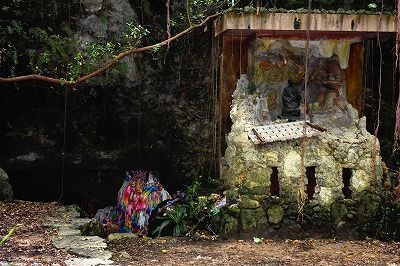 Minoru Kinjo’s destroyed sculpture “Icon of Peace Connecting Generations” at the entrance of the cave |
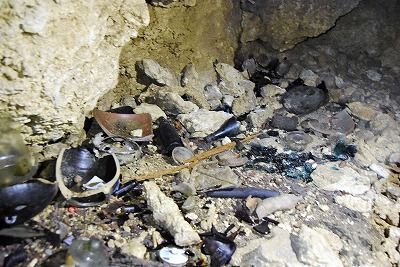 Smashed remains inside the cave |
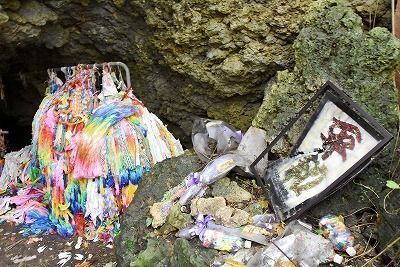 Inside of the ruined Chibichiri Gama |
 Vandalized Thousand Crane strings sent from all over the country |
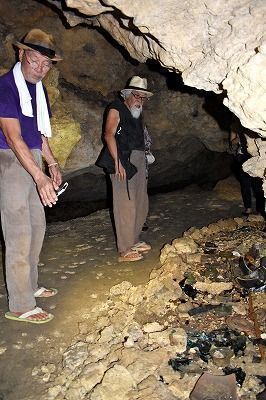 Shoichi Chibana showing Minoru Kinjo the broken bottles that contained water and gasoline |
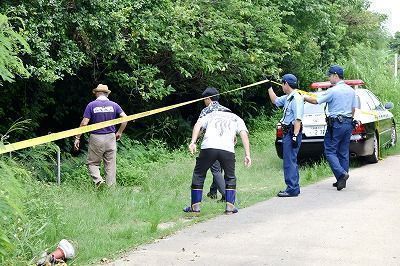 Police investigating with the help of Shoichi Chibana |
(English translation by T&CT and Sam Grieb)
Go to Japanese
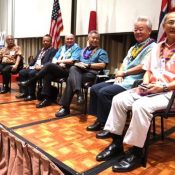
September 3, 2017 Ryukyu Shimpo
By Wu Li Jun
The Worldwide Uchinanchu Business Association (WUB), founded 20 years ago, held their 21st WUB Network Conference at Hawaii University’s East-West Center September 1.
The conference was attended by around 300 Uchinanchu from all over the world. The theme of this year’s conference was the Hawaiian word “hukilau,” which means to help one another while working together, and centered on strengthening the Uchinanchu network and promoting participation of future generations.
After the conference, they also had a celebration marking their 20th anniversary.
Opening ceremony greetings were given by Hawaiian Governor David Ige, Okinawa Vice-Governor Moritake Tomikawa, and the 7th President of the WUB, Steve Kishaba Sombrero.
Governor Ige said, “I realize that over the past 20 years, the Uchinanchu community has managed to come together after spreading throughout the globe.
Vice-Governor Tomikawa read a statement from Governor Takeshi Onaga, which stated, “The WUB’s engagement in business throughout the world holds immense significance in Okinawa.
This conference will assuredly lead to further economic and cultural development between Okinawa and the world.
President Sombrero added, “I want to grow the Uchinanchu network, and promote the participation of future generations.”
At the opening ceremony, all of the 6 previous WUB presidents gave keynote speeches.
There were also symposiums on green energy and building partnerships between colleges.
The WUB was founded in 1997, aiming to link people of Okinawan descent through business, cultural, and social activity.
The organization has about 500 members representing 24 chapters in 16 countries.
(English translation by T&CT and Sam Grieb)
Go to Japanese
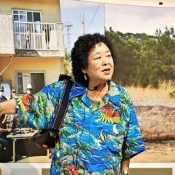
September 5, 2017 Ryukyu Shimpo online edition
On September 5 Mao Ishikawa’s photograph exhibition, the Great Ryukyu Photo Scroll parts 1-4, opened at Naha Civic Gallery in Kumoji, Naha City.
The same day Ishikawa conducted a gallery talk during which she gave some exposition about her photographs.
She mentioned that currently there is slander on the internet against the base opposition movement in Okinawa, including the complaint that many people involved in the movement are outsiders.
However, she continued, these people are taking time out of their daily lives to bring attention to these concerns.
She spoke about her motivation for creating the work, saying she thinks Okinawans especially must earnestly act to make these issues apparent.
Ishikawa, who harbors anger toward the government for pushing construction of the new facility in Henoko forward, began photographing for her Great Ryukyu Photo Scroll in 2013.
The exhibition is designed as a series of photographs set in historic scenery in Okinawa, with friends and acquaintances acting as models.
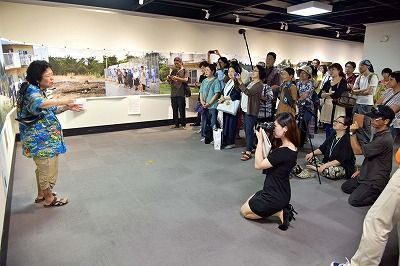
Mao Ishikawa and her audience on September 5 at Naha Civic Gallery
This year is the fourth of this exhibition, and 23 new pieces have been added. What differs from last year is that in many of her products really captured and represented the thoughts and feelings of people going about their daily lives.
She mentioned that all those photographed were ordinary people, not unusual in any way.
Right next to a photograph of a young woman protesting the Henoko base in front of a Camp Schwab gate, she displayed a photograph depicting the daily scene of a housewife doing housework with some children.
Ishikawa said that she did not only want to photograph people protesting by the gates, but also the families at home supporting these efforts.
There was also a photograph of a family gathered around their table eating New Year’s cuisine, encircled by men dressed like riot policemen.
Through this photograph Ishikawa is expressing how: “No matter how much violence they use, they will not snatch away our smiles or our love.”
While photographing for part 4 of her collection, Ishikawa discovered she had cancer, but continued her work despite the illness.
Now that she has made it through her medical procedures favorably, she is considering making a part 5.
This exhibition ends on September 10, and is currently open for viewing between 10:00 a.m. and 7:00 p.m., except that it is only open until 4:00 p.m. on the final day.
Admission is free. Ishikawa plans to be at the exhibition hall each day.
(English translation by T&CT and Erin Jones)
Go to Japanese

August 23, 2017 Ryukyu Shimpo
Three diomedea immutabilis birds were taken into care after they were lost in Okinawa due to the typhoon in early August.
Two of them were released on the 21-seiki no mori beach on August 22.
The two birds flew towards Nago-bay as people who cared for the birds looked on.
A diomedea immutabilis was found on the sidewalk of Hamagawa intersection in Chatan town on August 5, and the other two were found in the Nago fishery harbour on the 6th. The non-profit organization, dobutsu-tachi no byoin Okinawa (animals’ hospital in Okinawa) took care of the birds treating them using a drip system.
One of the two birds that were found at the Nago fishery harbour could not eat food and died on August 11.
A fifty-five year-old director of the hospital, Michio Kinjo, smiled as he said “we hope the birds will fly over the Pacific ocean freely and live long.”
(English translation by T&CT and Sayaka Sakuma)
Go to Japanese
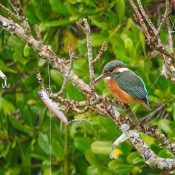
August 15, 2017 Ryukyu Shimpo
A large number of fishhooks and lures are being left around Kokuba river in Naha city, making the rivers dangerous for local species.
More people go fishing during the summer break season, and the city’s conservation department is calling for proper management saying, “don’t leave fishhooks.”
In February, lures were found on a tree where kingfishers perch when they looking for food during high tide at the Kokuba river.
In late July, the city officers collected more than ten lures around the river.
An officer from the conservation department pointed out, “lures and fishhooks are left in rivers and the ocean all the time, and there are a number of wild animals that get damaged by them.
” He further stressed, “please manage your fishhook and lures responsibly.”
(English translation by T&CT and Sayaka Sakuma)
Go to Japanese
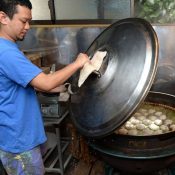
August 31, 2017 Ryukyu Shimpo
By Wakana Arakaki
Do not let the tradition cease. Hidefumi Yamashiro, the sixth-generation owner of the long established “Yamashiro Manju” in Shuri, Naha City, has decided to take over the business from his parents, who once thought to close the store due to their limited physical strength.
The community and regular customers said, “It would be sad if the shop disappeared,” and supported the decision.
After completing training which started in March, Yamashiro currently manages the store and makes 150 manju with the help of employees from the early morning.
Yamashiro stressed, “I am proud to inherit the tradition.”
Yamashiro recalled his childhood, saying; “My friends made fun of “Manjuuyaa.
” Yamashiro did not have much pride in the fact that his home was a long-established shop, so he initially had no intention to take over the store.
He operated “Hot Sandwich Café Sui” next to his parents’ store.
Yamashiro decided to succeed the shop and began the work, but getting up early in the morning was hard for him.
He woke up at 5 a.m. to prepare for the opening at 10:30 a.m.
He said, “I have a recipe, but I have never seen it. I have eaten manju since I was a child. I pick the bean paste and check the taste.
” With his sense of taste developed from his childhood, he reproduces the traditional taste that continues from pre-war times.
Yamashiro says, “Customers sometimes say that ‘the store is always closed, or manju is sold out,’ but now we can offer manju without making customers wait.
” Yamashiro left his hot sandwich shop and his younger brother Hidemichi now manages the store. Yamashiro said, “I hope the younger generation will eat more manju.
” He plans to offer manju at hot sandwich stores as a menu item.
(English translation by T&CT and Megumi Chibana)
Go to Japanese
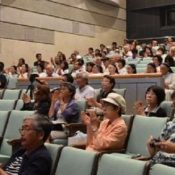
September 4, 2017 Ryukyu Shimpo
A symposium considering the impact of new base construction in Henoko on the surrounding environment and the Yambaru forest’s bid for UNESCO World Natural Heritage status was held on September 3 in Naha City.
Panelist Hideki Yoshikawa, international director of the Save the Dugong Campaign Center, stressed that the importance of the National Historic Preservation Act (NHPA), which was used in the Okinawa dugong lawsuit in the United States, could also be applied to a Noguchigera (Okinawa woodpecker) bird, which is designated as a national special natural treasure.
“If we convey to The Advisory Council on Historic Preservation (ACHP) what is really happening even without a new lawsuit, there is a possibility that the way will open,” Yoshikawa said.
The Advisory Council on Historic Preservation (ACHP) is an independent federal agency in the United States and advises government agencies regarding the NHPA, which protects historical and cultural heritage.
“We face challenges including language barriers, but it is an effective way for citizens to convey the current situation of Okinawa to appropriate institutions and agencies outside the country,” Yoshikawa said.
He stressed that the citizens themselves should take action because the government is unreliable, proceeding with having the Yambaru region recognized as a World Natural Heritage site while tolerating the negative impacts associated with the U.S. military activities there.
Panelist Kunitoshi Sakurai, an emeritus professor at Okinawa University, revealed that he had received advice regarding the construction of the new base from a historian of Japanese descent during their visit to the U.S. last month.
According to Sakurai, he was told it is possible that it might be a violation under the NHPA to build a military base for waging war at the former Ourasaki Camp in the U.S. military’s Camp Schwab, where many war dead are still buried and the work of collecting remains has not been completed.
“We have to rack our brains to find a way and use all measures to block the new base’s construction,” Sakurai said to participants.
At the symposium, there were speeches by Nago Mayor Susumu Inamine, Takuma Higashionna, a Nago City Assembly member and a plaintiff of the Okinawa dugong lawsuit, and a concert by Yutaka Umisedo.
(English translation by T&CT)
Go to Japanese
September 1, 2017 Ryukyu Shimpo
By Chie Tome
After a high concentration of perfluorooctanesulfonic acid (PFOS) was discovered at the Chatan Water Treatment Plant in Okinawa Prefecture, which takes in water from rivers near U.S. military bases, the prefectural government’s Enterprise Bureau spent 170 million yen in fiscal 2016 on decontamination measures.
It has now been revealed that the Enterprise Bureau expects it might raise water rates if the problem continues.
The Enterprise Bureau conveyed its concerns to the U.S. military that the cost of decontamination could be a major factor leading to an increase in water rates.
This was revealed in the minutes of a three-party conference among the Okinawa prefectural government, the Okinawa Defense Bureau, and the U.S. military.
The document was obtained by Masami Kawamura of the Informed-Public Project (IPP) via a disclosure request on August 31.
The prefectural government is requesting compensation from the Okinawa Defense Bureau (ODB) for the decontamination costs, but the ODB has refused to comply, asserting that no causal relationship has been established between the U.S. military bases and the PFOS contamination.
The high cost of decontamination incurred by the prefectural government can be viewed as a form of secondary damage caused by the bases.
In fiscal 2016, the Enterprise Bureau spent 170 million yen to replace granular activated carbon, which is effective at removing PFOS from water.
According to prefectural government documents, it has been decided that the granular activated carbon will be replaced yearly at least until 2023, meaning the Enterprise Bureau will incur massive costs to perform decontamination.
Since the PFOS detection was made public in January of last year, the prefectural government held three-party talks with the ODB and the U.S. military on two occasions to exchange information on the PFOS issue.
The three parties shared information about PFOS concentration measurements and the prefectural government’s response to the issue.
At the meeting in February of this year, the Enterprise Bureau explained the situation of the decontamination costs and also conveyed the possibility of raising water rates.
A representative of the Enterprise Bureau explained, “The change will not be immediate, but if we continue to incur such costs, we will have no choice but to increase water rates.
” The representative repeated the prefectural government’s frequent assertion of its need to enter into U.S. bases to survey the situation and also called on the ODB to compensate the prefectural government for the decontamination costs.
According to a representative of Ginowan City, where all homes receive their water supply from the Chatan Water Treatment Plant, the city has not been contacted by the Enterprise Bureau regarding an increase in water rates.
The representative stated, “Residents are unlikely to be pleased if they see their water rates go up because of pollution originating from the bases.”
(English translation by T&CT and Sandi Aritza)
Go to Japanese



















 Webcam(Kokusai Street)
Webcam(Kokusai Street)


